#the bishop of Avranches
Explore tagged Tumblr posts
Text
Monte Saint-Michel, Normandy, France
© Captain Skyhigh
Getty Images

Discover Mont-Saint-Michel in Normandy, the protagonist of our image of the day! This French corner combines the tides with mediaeval history in a rock full of mysticism. According to legend, in the eighth century, the Archangel Michael appeared in a vision to the bishop of Avranches, asking him to build a sanctuary in this mystical rock. Thus was born the majestic abbey that still stands on the island, a spiritual lighthouse that has served as a refuge for monks and pilgrims over the centuries. Today, a World Heritage Site, it fascinates with its impressive tidal cycle. When the tide is low, an extensive sandy plain emerges, allowing access on foot; but when it rises, the sea surrounds the mountain, isolating it in its mystery.
#Captain Skyhigh#getty images#Monte Saint-Michel#Normandy France#archangel michael#the bishop of Avranches#world heritage site#the mountain#isolating it in its mystery#artists photographie#art#original art#original photographer#photographer#art style#black and white photography#photo color#ambient color#colors nature#art colors#de tot#fotos art#xpuigc#xpuigc bloc
8 notes
·
View notes
Text

Fun fact about the castle in background: The legend of Mont Saint-Michel tells that in 708, the Archangel Michael appeared to Bishop Aubert of Avranches in a dream, ordering him to build a sanctuary on the rocky islet, Mont Tombe, which later became Mont Saint-Michel. - courtesy of Google.
#liminal#liminalcore#liminal spaces#liminal blog#liminal aesthetic#weirdcore#weirdcore aesthetic#dreamcore#nostalgia#nostaligiacore#2000s nostalgia#dreamcore aesthetic#angelcore#webcore#Hazbin hotel#hazbin hotel blog#i write fanfiction#currently for hazbin hotel tho#trying to be more active#this blog is basically if hazbin and Weirdcore had a baby#i need to sleeeeep
7 notes
·
View notes
Photo




Saint of the Day – 13 December – Saint Aubertus of Cambrai-Arras (c600-c669) Bishop and Confessor, Monk and Hermit, Apostle of the poor, Founder of several Churches and Monasteries in the region of what is now Belgium. Born in France in c600 and died there in c669 of natural causes. Patronages – of bakers and confectioners, merchants, Cambrai, France, Ghent, Belgium, Hainault, Belgium. Also known as – Aubert of Cambrai, Aubert of Cambrai-Arras, Aubert of Avranches , Albert…Audebertus…Authbert…Autbertus…Obrecht… The Roman Martyrology reads today: “At Cambrai, in France, St Aubertus, Bishop and Confessor.”
(via Saint of the Day – 13 December – Saint Aubertus of Cambrai-Arras (c600-c669) Bishop and Confessor, – AnaStpaul)
2 notes
·
View notes
Text
Iconic Mont Saint-Michel Abbey celebrates 1,000 years
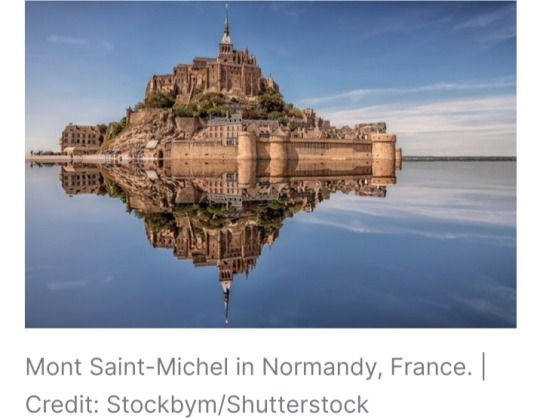
By Solène Tadié
13 June 2023
It was exactly a millennium ago that the first stone of the abbey church of Mont Saint-Michel in French Normandy was laid.
The monument that the poet Victor Hugo called the “Khéops of the West” has since become one of the highest symbols of French Catholic identity and one of the most important pilgrimage sites in the world, with more than 3 million visitors a year.
This important anniversary will give rise to a number of celebrations that will continue through the fall of 2023.
Standing on relatively inhospitable terrain, enthroned on a rocky islet less than a kilometer in diameter, surrounded by a vast sandy plain subject to the vagaries of the tides, the UNESCO World Heritage Site has stood the test of time, offering itself as a spectacle for dozens of generations to see.
Indeed, the history of this place of prayer and pilgrimage was as precarious and tumultuous as its surroundings.
While the construction of the present abbey church dates back to 1023, a first church dedicated to St. Michael the Archangel is said to have been built as early as 708 on the mount, then known as Mont-Tombe.
According to “Revelation,” the oldest text reporting the context of the abbey’s construction (written around the beginning of the 11th century), St. Aubert, then-bishop of Avranches, was visited three times in a dream by the archangel, who instructed him to erect a sanctuary in his honor on the summit of the site “so that he whose venerable commemoration was celebrated at Mont Gargan [the first great shrine dedicated to the Leader of the Celest Army, in the Puglia region of Italy] might be celebrated with no less fervor in the middle of the sea.”

St. Aubert undertook the building of a first church with the capacity of about a hundred people, consecrated in October 709 and given the name Mont-Saint-Michel-au-péril-de-la-Mer.
The prelate installed 12 canons there, responsible for praying the Divine Office and welcoming local pilgrims.
The canons were replaced in the 10th century by Benedictine monks at the behest of Richard I, Duke of Normandy, who had little taste for the canons’ opulent lifestyle.
In 1023, the order undertook the construction of the abbey church we know today, based on three rock-cut crypts and the former chapel.
This ambitious project marked a decisive step in the international outreach of the site, where miracles abounded as the flow of pilgrims from all over Christendom expanded.
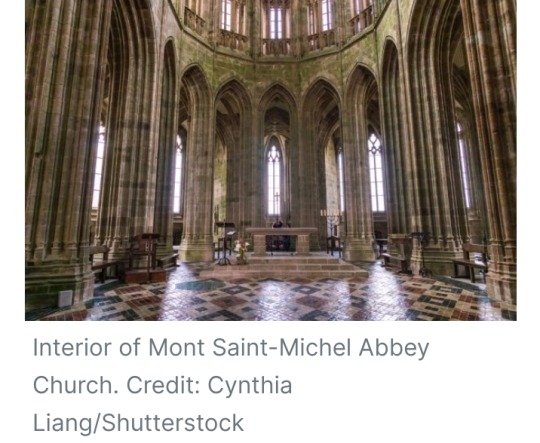
“This edifice is like Noah’s ark laid over the crypts,” said François Saint-James, a guide and lecturer at Mont Saint-Michel, in an interview with Le Devoir newspaper, underlining the architectural prowess required for this medieval project.
“It was a time when France was covered with a white cloak of churches, as a monk from Cluny once wrote. You have to imagine the gigantic scale of the work.
The granite blocks were cut on the Chausey islands, 34 kilometers from here.
Caen stone, a soft, light stone that’s easy to carve, was used. ... When, in the midst of the Hundred Years’ War, the Romanesque choir collapsed, it was rebuilt in flamboyant Gothic style.”
While the abbey’s architectural evolution continued uninterrupted until the 19th century, one of its highest points was the construction of “La Merveille” (The Wonder) in the 13th century, a jewel of Norman Gothic art.
It consists of two buildings on three levels, supported by high buttresses, with a cloister and refectory, 80 meters above sea level, beneath which were built an almshouse, a storeroom, and guest rooms.
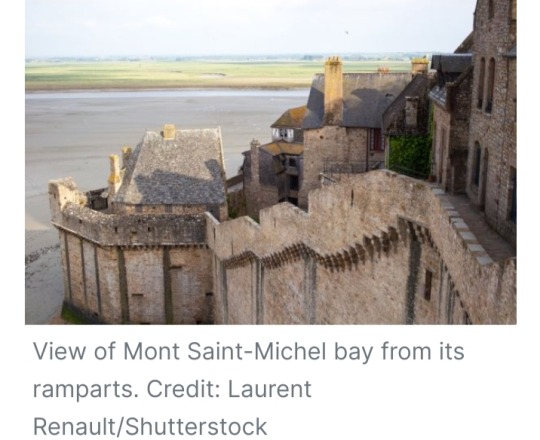
The fame of the shrine started to decline in the 17th century, when part of the abbey was turned into a prison by the royal power.
Seized by central government during the revolution, it became a detention center for priests deemed hostile to the Jacobin terror.
In the 19th century, the site, listed as a historic monument in 1874, was gradually returned to monastic life and its original vocation as a sanctuary.
The abbey’s distinctive silhouette was further enhanced by a neo-Gothic spire in 1897, topped by a gilded statue of the archangel.

To mark its 1,000th anniversary, a special tribute is being paid to the abbey that many have dubbed the “Wonder of the West” with the exhibition “La Demeure de l’Archange” (The Archangel’s Abode), retracing its glorious and tumultuous history through some 30 masterpieces, until November 5.
Many of these items, which include sculptures, scale models, statues, and silverware, will be on display to visitors to the abbey for the first time.

Another highlight of the many celebrations taking place over the summer and part of the autumn will be the “Millennium Solstice,” a never-before-seen light show projected onto Mont Saint-Michel from various spots in the bay on the evening of June 23.
The beauty of this sacred site, trodden by millions of pilgrims over the centuries, has been celebrated and immortalized in the writings of many great men of letters over the last few centuries, from Gustave Flaubert to Théophile Gautier and Victor Hugo.
In particular, it inspired the novel “Les Merveilles du Mont Saint-Michel” (1879) by the prolific writer Paul Féval.
He had already paid tribute to the monument a few years earlier, in “La Fée des grèves,” with these lines often quoted by admirers of the famous Mont:
“Twilight broke. Mont-Saint-Michel was the first to emerge from the shadows, offering the golden wings of its archangel to the reflections of the dawning dawn; then the sides of Normandy and Brittany lit up in turn.
Then again, a sort of light steam seemed to rise from the receding sea, and all was veiled except for the statue of Saint Michael, which dominated this wide ocean of mist.”
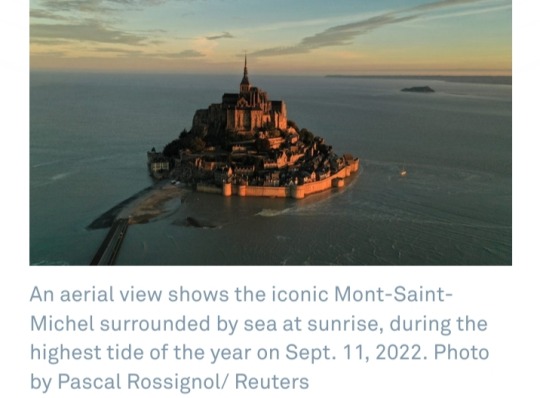
#Mont Saint-Michel#Khéops of the West#Victor Hugo#UNESCO World Heritage Site#pilgrimage#St. Aubert#Revelation#Mont-Saint-Michel-au-péril-de-la-Mer#Richard I#Duke of Normandy#La Demeure de l’Archange#The Archangel’s Abode#Millennium Solstice#Gustave Flaubert#Théophile Gautier#Paul Féval#Les Merveilles du Mont Saint-Michel#La Fée des grèves#St. Michael the Archangel
29 notes
·
View notes
Text
Braose, descendant of a family with more than a century of Marcher history and experience, already held the lordships of Brecon, Builth, Radnor and Abergavenny and had annexed Elfael by 1195. His elder son had custody of Monmouth until 1205 and another, Giles, became bishop of Hereford in 1200. William, sheriff of "Herefordshire in Wales" in 1199 was truly an earl of March' manqué and his subsequent career almost reads like a sub-text of John's reign. The Marshal, seised de uxore of Striguil and Usk in 1189, was only episodically a major force in the March and the same is even truer of Earl Ranulf of Chester. This has not prevented historians from regarding Ranulf as part of John's balancing act in the March as he sought an equilibrium between the three major interests of Chester, Braose and the Marshal (as if a revival of the earlier tinity of Avranches, Montgomery and Fitz Osbern!). Earl Ranulf assuredly had a vulnerable frontier against Gwynedd yet the twelfth-century earls of Chester were, in so far as Wales was concerned, "dogs that did not bark in the night". Ranulf may have sought to protect his flank by making overtures to Gwenwynwyn of Powys in 1204 and by building castles at Deganwy and Holywell in 1210 but his political ambitions and horizons lay elsewhere - in Richmondshire and the Midlands. It is arguable that a more robust stance on his western frontier by Earl Ranulf after 1199, when Mold was lost, may have deterred Llywelyn, but he had significant other priorities. As to the rest of the triumvirate the further promotion of Braose in the Middle March was likely prompted by the menace of Gwenwynwyn while the claim of Marshal upon Pembroke would have been difficult to resist. Other Marchers or frontier lords such as Clifford, Monmouth, Lacy, Mortimer and fitz Alan carried weight, as it were, as leaders of Welsh levies and as an affinity. In turn bullied and seduced by John, the first four became active royal partisans in 1215-16, calculating that by then they had more to fear from the Welsh than from the Crown.
-Ifor W. Rowlands, King John and Wales
1 note
·
View note
Text
Mont Saint Michel
September 30, 2023.
We awoke early and said good-bye to "nos cheri" Francoise. What a delight to meet her and I had a lump in the throat as we said good-bye even though it is for just 4 months.
Our final destination for the day in Paris - but we could not be this close to Mont St. Michel and not see it.
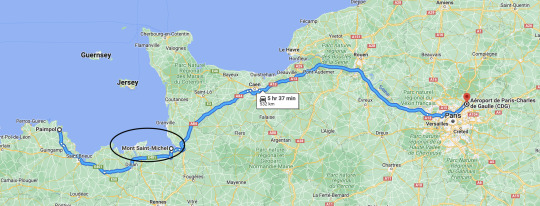
Annie & Carl had been there - but they insisted we go since Mark and I had not.
Let me just say WOWZA!!! You can see this from miles away - FYI.

If you want better pictures and a professional explanation here is a 5 minute snippet from Rick Steve's show on Normandy. Go to minute 21 if you just want to learn about Mont Saint Michel. It is great and will give you a good look at all the steps Annie and I climbed to get to that Abbey.
However, this film was done in 2004 so there have been some changes - not in the abbey - but in the approach to the Abbey. Gone is the causeway.
Beginning in 2009 the causeway and parking areas were removed. It was replaced by a bridge open to the residents on the town (less that 50 at latest count), delivery trucks and shuttles to bring the millions of visitors to the Abbey. Since April 2014, the new car park on the mainland has been located 1.5 miles from the island. Visitors can walk or use shuttles to cross the causeway. The light bridge allows the waters to flow freely around the island and improves the efficiency of the now operational dam. The island is once again an island.
I have a little more info about how this abbey became an abbey too. According to a legend, the archangel Michael appeared in 708 to Aubert of Avranches, the bishop of Avranches, and instructed him to build a church on the rocky islet. But the bishop thought his dream was just that - a dream. Weeks passed and Michael came again. Still, the bishop thought - surely this didn't happen. The third time came and Michael was a little ticked off. He once again commanded him to build an Abbey and church to honor St. Michael and this time he put his finger on Aubert's head - a little too hard and caused a hole in his skull. When he awoke with the hole in his head - he thought - uh-oh, I better get busy! The first part of the abbey was dedicated on 16 October 709. The picture below is from that first building.
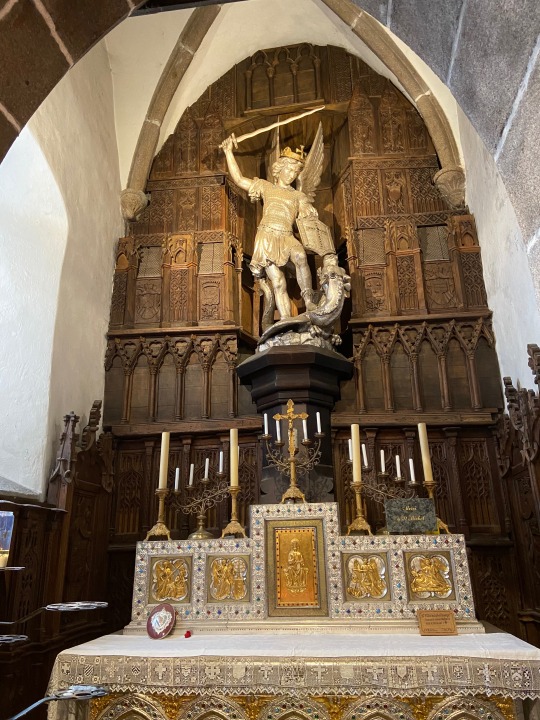
And to prove that that story is 100% true, Aubert's skull, complete with hole where the archangel's finger pierced it, can still be seen at the Saint-Gervais Basilica in Avranches, Normandy.
Now, today is place is still a pilgrimage site - but most of the people who visit have no religious interest in St. Aubert or St. Michel. They are just tourists and stores abound everywhere to fleece those tourists. BUT - and this is interesting - once the first part of the abbey was built the monks created flyers and distributed them all around Europe encouraging a pilgrimage to Mont. Saint Michel. Then they built inns and restaurants and stores to buy items made by the monks. - like pieces of word with a cross branded into the wood. The church recognized the this was a steady income source and as the abbey grew so did the town.
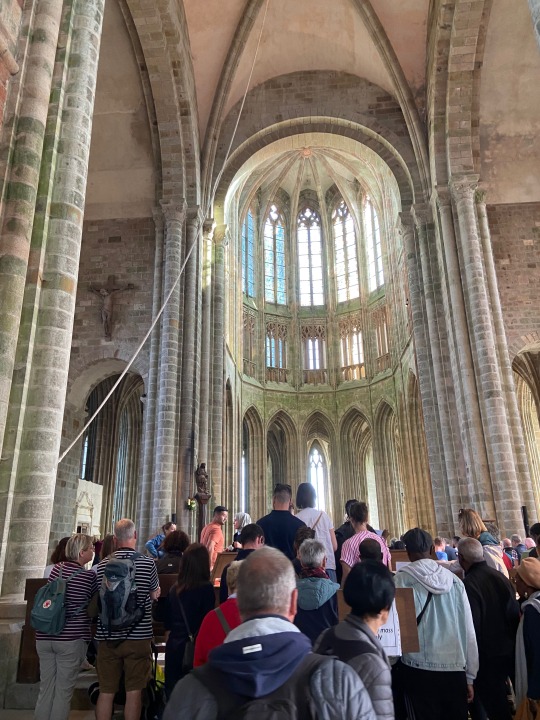


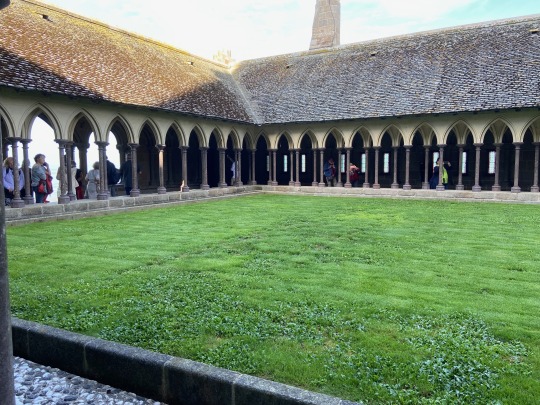
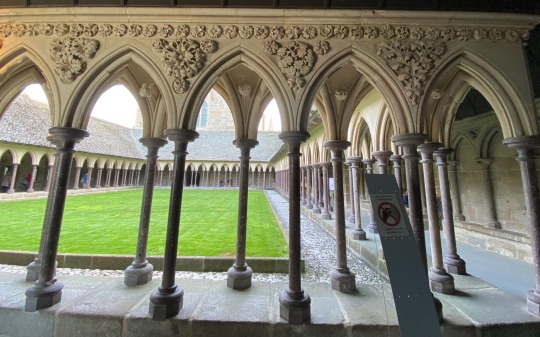
The cloisters were beautiful.
Rick Steves says that the tide comes in and goes out at the speed of a galloping horse - but that is not true. It is a legend that has lived more than 1000 year though. The highest tides in continental Europe are found at Mont Saint-Michel, reaching a difference of up to 15 metres (45 ft!) between low and high tide. During high tides, the sea withdraws 15 kilometres from the coast and rises very quickly.The tide is AMAZING but it travels about the average speed of a fit person jogging.
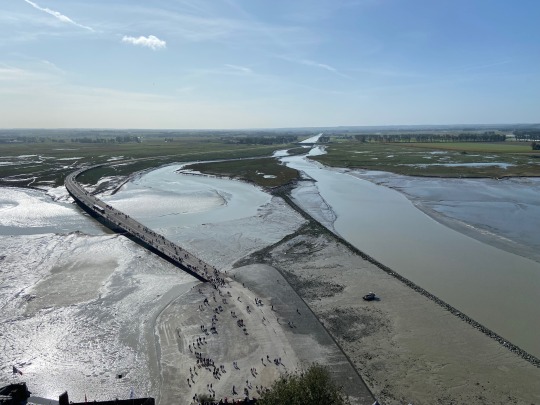
The Abbey was used as a prison during the Napoleon times and one of the most interesting things was that there was a lift or a crane there to bring up supplies. Under the reign of Louis-Philippe d’Orléans (1773-1850), there was a population of approximately 700 prisoners. A fire destroyed in 1834 the roof of the abbey. By 1852, due to problems with the tides, the supply of the prison became very difficult. The poor state of the prison was such that it became inoperable, which forced Napoleon III to close it in 1863. The prisoners were transferred to other prisons and the abbey was rented to the bishop of Coutances.
Convicts were used for the operation of the Treadwheel crane, walking inside the wheel. Possibly there were two for each wheel and the estimated load capacity was three tons. The diameter of the crane wheels is 4.3 meters. There are indications that there was another Treadwheel crane of somewhat smaller size on the north side, to supply the winery. More than lifting loads were used as drag. So you can say that more than a treadwheel crane was a treadmill crane
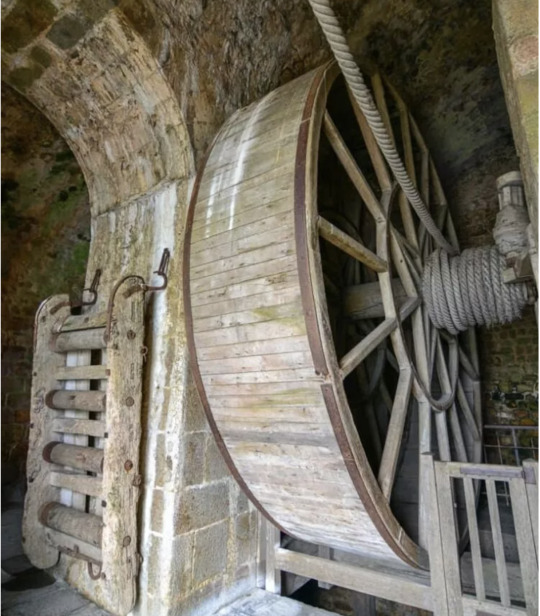
I have no idea how many steps we climbed but I think my watch said 21 flights. I believe THAT! We asked an employee where the restrooms were and she said - "just up 90 steps." You can imagine my surprise when the bathrooms were in the middle of a flight of stairs.

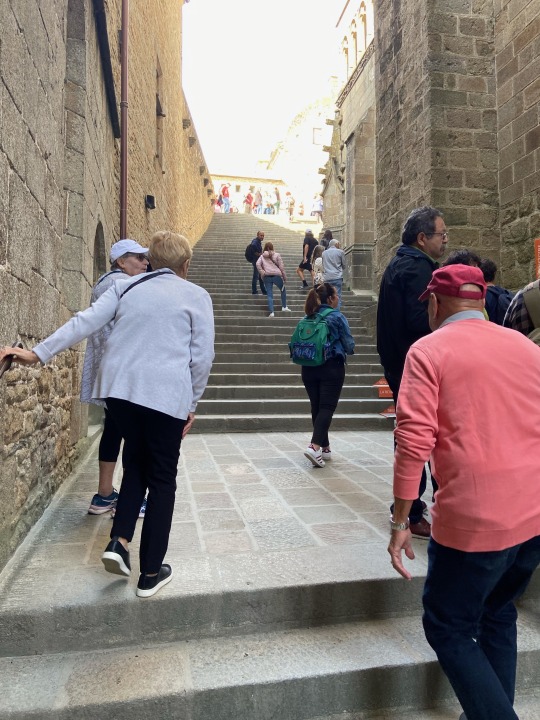
At the top of the steps we finally reached the cathedral

The place is simply breath-taking. We stayed about 4 hours total. Annie and I took a t2- hour tour and the guys found a place to sit and chat while they waited on us to meet them for lunch.
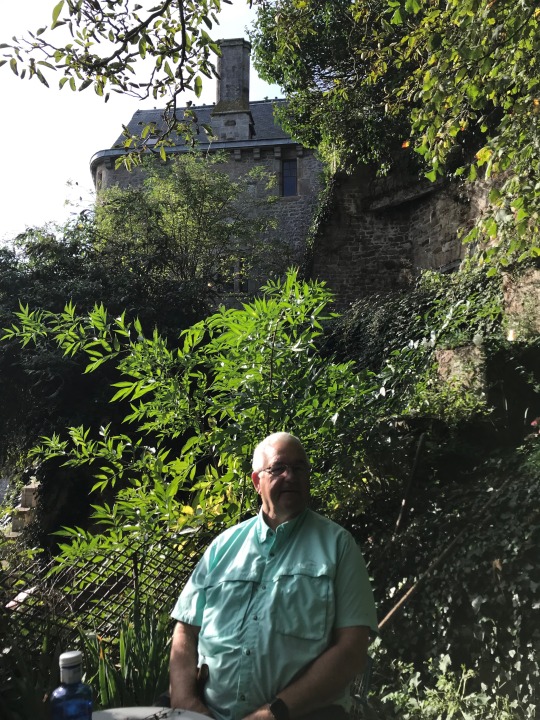
They found a very small garden with a table and a couple of chairs and they were very happy.
When we arrived it looked like this:

When we left it looked like this:
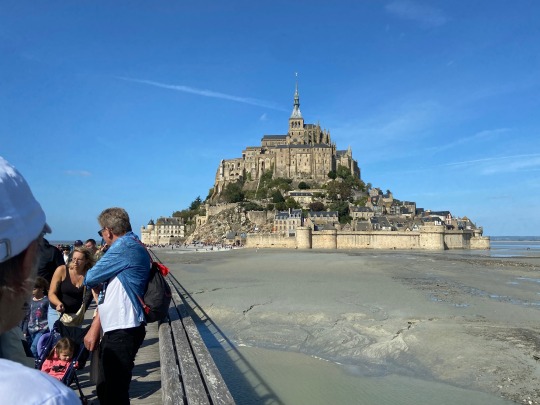
And there were people everywhere on the mudflats.
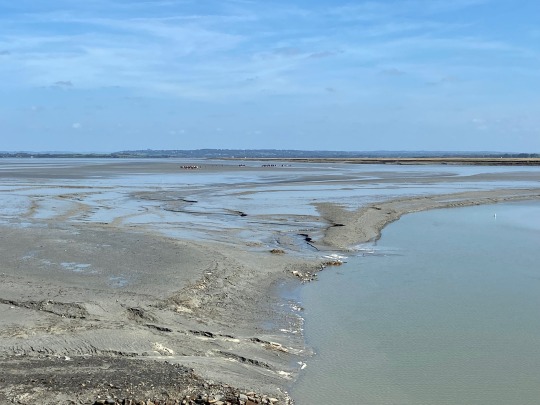
It is quite a place and we're glad we got the chance to see it. We didn't see it at night - but now it is much easier to imagine.
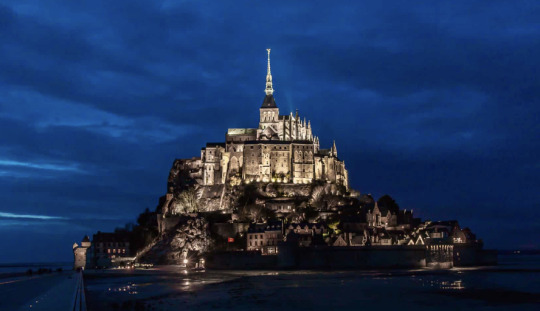
We continued on toward Paris and we arrived at our hotel around 8:00. Thank you so much Annie & Carl. Great friends and so easy to be with. Lucky us.

As you know - we took our flight home on October 1 without incident. My brother picked us up and our Mom celebrated her 97th birthday.

Happy Birthday Mom!
We have had a amazing month of travel. We are happy to be home, but feel energized by all we have seen and done. Travel is the best education!!! So, signing off.

Mark and Gayl
0 notes
Text
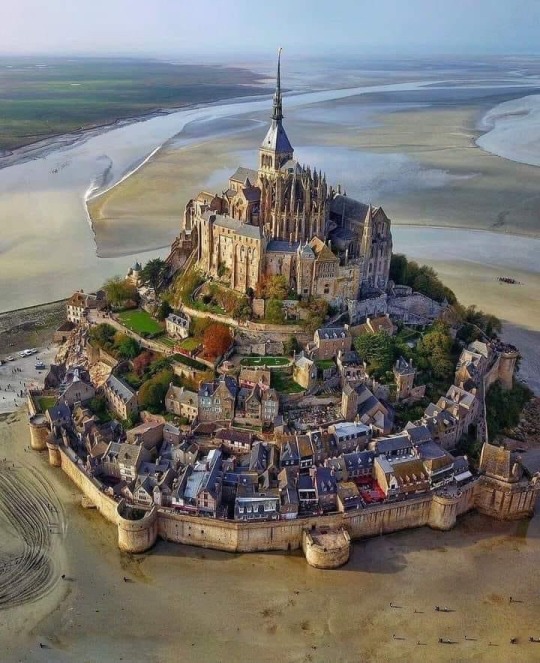
🇫🇷 Le Mont-Saint-Michel (pronounced [mɔ̃ sɛ̃ mi.ʃɛl]; English: Saint Michael's Mount) is an island and commune in Normandy, France. It is in the Manche department. It is located about one kilometre (0.6 miles) from the country's northwestern coast. It is at the mouth of the Couesnon River near Avranches. It is 247 acres (100 ha) in size and it has a population of 44 (2009). People that live there are called the Montois. The island has had strategic fortifications since ancient times. The name Mont-Saint-Michel comes from the monastery built there in the eighth century AD. The way in which the town is built is an example of how feudal society worked. At the top there is God, the abbey and monastery. Below this, there are the great halls, then stores and houses. At the bottom, outside the walls, there are the houses of fishermen and farmers.
Mont-Saint-Michel is one of France's most famous landmarks. The island and its bay are part of the UNESCO list of World Heritage Sites. Every year, more than 3 million people visit it.
History
Mont-Saint-Michel was an Armorican stronghold of Gallo-Roman culture in the sixth and seventh centuries. In the seventh century, the Franks took the mount. From about the fifth to the eighth century, Mont-Saint-Michel was part of a region called Neustria. At the start of the ninth century, it was an important place in the marches of Neustria.
Inside the walls of Mont-Saint-Michel.
Before the eighth century, the island was called Mont Tombe (Latin: tumba). The Catholic Church built the first religious building in the eighth century, and the mount became Mont-Saint-Michel. According to legend, the Archangel Michael appeared in 708 to St. Aubert, the bishop of Avranches. The angel told him to build a church on the mount. Aubert didn't listen to the angel until Michael burned a hole in the bishop's skull with his finger.
The king of the Franks could not defend his kingdom against the attacks of the Vikings. The king agreed to give the Cotentin peninsula and the Avranchin, including Mont-Saint-Michel, to the Bretons in the 867 Treaty of Compiègne. For a short time, the mount belonged to the Bretons. In effect, these lands and Mont-Saint-Michel never belonged to the duchy of Brittany. They remained separate bishoprics from the newly created Breton archbishopric of Dol. When Rollo named Franco as archbishop of Rouen, the diocese of Rouen took the lands and the mount. They became part of Normandy once again, but not officially.
The mount became strategically important again in 933 when William "Long Sword" (the Duke of Normandy) annexed the Cotentin Peninsula from the weakened Dukes of Brittany. This made the mount part of Normandy officially. This is shown in the Bayeux Tapestry, which commemorates (helps remember) the Norman conquest of England in 1066. The tapestry shows Harold, Earl of Wessex helping two Norman knights from the quicksand around Mont-Saint-Michel during a battle with Conan II, Duke of Brittany. Norman dukes paid for the development of the abbey in the following centuries. It became a good example of Norman architecture.
In 1067, the monastery of Mont-Saint-Michel gave its support to Duke William of Normandy in his claim to the throne of England. William gave houses and grounds on the English side of the Channel as a reward. These included a small island off the southwestern coast of Cornwall. It became a Norman priory named St Michael's Mount of Penzance. It looks similar to Mont-Saint-Michel.
During the Hundred Years' War, the English made many attacks on the island. They were not able to take it due to the abbey's very good fortifications. The English first attacked the mount in 1423, and then again in 1433. Thomas Scalles was the leader of the English army. Scalles left two wrought iron bombards when he stopped his attack. They are still there today. They are known as les Michelettes. The resistance at Mont-Saint-Michel gave hope to the French, especially Joan of Arc.
Cannons left by Thomas Scalles at Mont-Saint-Michel on 17 June 1434. Currently (June 2013), only the second cannon, the one closer to the wall, is shown. It is inside the entrance to the mount's outer wall.
When Louis XI of France founded the Order of Saint Michael in 1469, he wanted the church of Mont-Saint-Michel to become the chapel for the Order. However, it was far from Paris so this was not possible.
The wealth and influence of the abbey helped other foundations, for example St Michael's Mount in Cornwall. However, it started to become less popular as a centre of pilgrimage due to the Reformation. At the time of the French Revolution, there were almost no monks living there. The republicans closed the abbey. It became a prison. At first, this was to hold clerical enemies of the French republic. Later, there were also important political prisoners at the mount. In 1836, famous figures, such as Victor Hugo, started a campaign to restore the mount. The prison closed in 1863, and the mount became a historic monument in 1874. Mont-Saint-Michel and its bay became UNESCO World Heritage Sites in 1979. The factors for listing included cultural, historical, and architectural importance, as well as man-made and natural beauty.
Plan of the mount
In the 11th century, Richard II of Normandy chose an Italian architect called William de Volpiano to build the abbey of Mont-Saint-Michel. Volpiano had already built the Abbey of Fécamp, in Normandy. He designed the Romanesque church of the abbey. He chose to place the transept crossing at the top of the mount. He also built a lot of crypts and chapels below the ground. These are to support building above, because it is very heavy. Today, Mont-Saint-Michel has a church of Romanesque style.
Robert de Thorigny was a great supporter of Henry II of England. Henry was also Duke of Normandy at this time. Thorigny made the structure of the buildings stronger. He also built the main façade of the church in the 12th century. In 1204, the Breton Guy de Thouars, a friend of the King of France, attacked the mount with an army. He set fire to the village and killed lots of people. However, he had to retreat (leave) under the powerful walls of the abbey. The fire extended to the buildings, and the roofs burnt. Philip Augustus, Thorigny's friend, was unhappy about the cruel actions and the destruction. He offered Abbot Jourdain some money to build a new Gothic-style architectural set. The abbot added the refectory (dining room) and cloister.
Charles VI added big fortifications to the abbey-mount. He also added building towers and courtyards, and he made the ramparts stronger.
CC iDrone Aerials
#YourEarth #view #dronephotography #france 👉👉👉👉 Most Beautiful Images ��� em Monte Saint-Michel.
13 notes
·
View notes
Photo
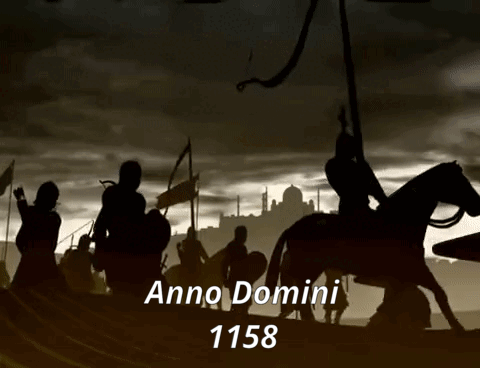

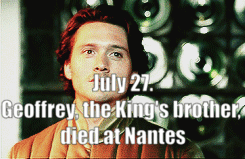

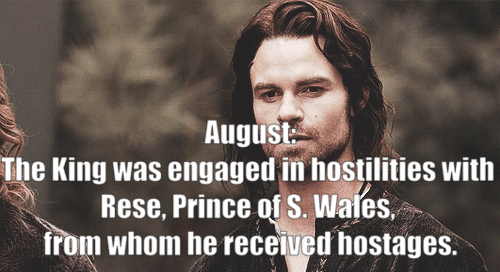
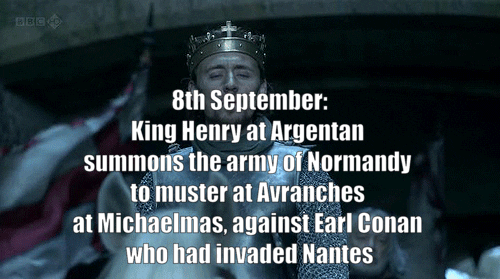
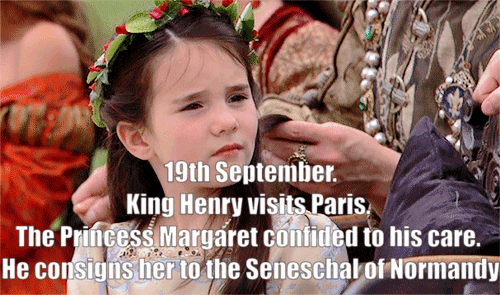
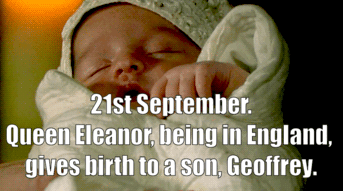
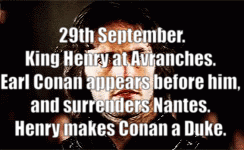
Selected events of Henry II’s reign.
<<A.D. 1158>>
Jan: The King at Carlisle, grants the honour of knighthood to William Earl Warren, but refuses it to Malcolm, King of Scots.[...] The King fortifies the Castle of Were, i.e., Wark in Wark, or Werk. Northumberland.
A Charter, dated at Nottingham, and addressed to Nottingham. Robert, Bishop of Lincoln; whereby the King certifies that he has restored Ricardo de Haia Constabularlam suam de Lincolscira et custodiani castelli mei de Lincoln* et terram qua fiiit joatris ejus. Witnesses, Thorms the Chancellor; Reginald, Earl of Cornwall; William, the King's brother; Richard de Humez, Constable; Robert de Novo-burgo ; R. de Sancto Remigio. A Charter, dated at Nottingham in favour of Furness Abbey, attested by Earl Reginald (of Cornwall) ; Robert, Earl of Leicester; Warin fitz Gerold, Chamberlain ; and Manasser Biset, Dapifer.
Feb-March: During these two months the King probably visited Oxfordshire, Hampshire, and Wiltshire. The Charters which we may refer to this period, are:
One, dated at Woodstock, whereby the King gives "to William Malduit, son of William Malduit, my Chamberlain, the Barcny which was his father's on the day that he became the King's man at Wudestoc, to wit, Hameslape and Maneton, which I gave to his father at Nottingham."
Witnesses, Robert, Bishop of Lincoln; Thomas the Chancellor; Richard de Haia; Robert de Montfort ; William de St. John ; William de Caisneto ; Hugh de Piris; William de Lanval ; and William de Watevill. [...]
April: [...] from Worcester, it is probable that the King passed to Tewkesbury. A Writ, there dated, and attested by Tewkesbury. Gregory (perhaps a clerk of the King), admonishes the tenants of the Abbey of Malmesbury that they perform due services to the Abbey.
This year is distinguished as one in which the King is said to have made a summer progress. [...] there is some probability that between April and August of this year, the King visited London. — A Charter, dated at Westminster, is in favour of Bermondsey Priory, and is attested by Theobald, Archbishop of Canterbury ; Thomas the Chancellor; and Manasser Biset, Dapifer.
July 27: Geoffrey, the King’s brother, died at Nantes.
August. Just before his transfretation to Normandy, was engaged in hostilities with Rese, Prince of S. Wales, from whom he (South Wales.) received hostages.
The year 1158 must be assigned to this fact (if such it was), not the year 1157, as the Welsh Chronicle has it. In the same month of August the King crossed the Portsmouth or sea to Normandy. He probably embarked from Portsmouth or Southampton, leaving the Queen at Winchester.
King Henry holds a conference with Louis VII. on the inter Gisors and River Epte. They agree on a marriage between Prince Henry of England and the Princess Margaret of France.
September:
8th. King Henry at Argentan summons the army of Normandy to muster at Avranches at Michaelmas, against Earl Conan who had invaded Nantes.
19th. King Henry visits Paris. The Princess Margaret confided to his care. He consigns her to Robert de Newburg (then Seneschal of Normandy). The King is said to have been now at Mantes.
21st. Queen Eleanor, being in England, gives birth to a son, Geoffrey.
29th. King Henry at Avranches. Earl Conan appears before him, and surrenders Nantes. Henry makes Conan a Duke. The Chancellor (Becket) and Henry de Pomerai appear in the above year, acting exceptionally and in three counties, as judicial functionaries. There was no regular Iter in the English provinces.
October:
9th. Oct. 9. The King goes to Nantes, in Bretagne. He is armed with additional powers against the disaffected Bretons in virtue of his office as Seneschal of France.The King besieges and takes Thouars (Castrum Toarcii). The King goes to Le Mans/ and there meets Louis of France.
November:
23rd: The King accompanies Louis VII visiting the Norman Abbey of St. Michael in periculo maris (Mont St. Michael). Both Kings adjourn to Avranches.K. Henry is next found at Baieux with Louis. Then at Caen. Then at Rouen, still entertaining Louis. Another authority seems to trace a nearly contemporary progress of the King through Normandy as bringing him successively to Pacey. And to Evreux. And to Neufbourg. And to Bee.
29th. The Queen is now at Salisbury. Richard de Luci is acting as a Justiciar in England. We have a precept of "Alianore, Queen of England, Duchess of Aquitaine and Normandy, and Countess of Anjou" in behalf of Matilda, Countess (dowager) of Chester. It is dated at Salisbury, and attested by Joceline de Bailol. Also we have a Certificate whereby " A.,Queen of England, etc.," confirms a quit-claim given in her presence by Robert Flambard to Warner de Lusoriis. Witnesses, Gosceline, Bp of Sarum; Earl Reginald
Sources: “Court, Household and Itinerary of K. Henry II”.
Fancast: Tom Hiddleston as King Henry II of England; Sam Claffin as Earl Conan; David Oakes as Geoffrey of Anjou; Daniel Gillies as Reese, Prince of South Wales. (Gifs are not mine to claim ownership. They are only used here to illustrate the characters and events of history.)
#Henry II of England#Henry II#King Henry II of England#King Henry II#Henry Fitzempress#Henry Curtmantle#House of Anjou#Angevins#Angevin Empire#Angevin Emperor#House of Plantagenet#Plantagenet#Plantagenets#Plantagenet Dynasty#Tom Hiddleston#David Oakes#Sam Claffin#Plantagenet edit#Eleanor of Aquitaine#Geoffrey Plantagenet#Geoffrey of Brittanny#Matilda of Normandy#Matilda of England
18 notes
·
View notes
Text
Today the Church remembers St. Anselm of Canterbury.
Ora pro nobis.
Saint Anselm of Canterbury, (born AD 1033/34, Aosta, Lombardy—died April 21, 1109, possibly at Canterbury, Kent, England) was annItalian-born theologian and philosopher, known as the father of Scholasticism, a philosophical school of thought that dominated the Middle Ages. He was recognized in modern times as the originator of the ontological argument for the existence of God (based on the idea of an absolutely perfect being, the fact of the idea being in itself a demonstration of existence) and the satisfaction theory of the atonement or redemption (based on the feudal theory of making satisfaction or recompense according to the status of a person against whom an offense has been committed, the infinite God being the offended party and humanity the offender). There is incomplete evidence that he was canonized in 1163, though some scholars contend that he was canonized by Pope Alexander VI in 1494.
Early Life And Career
Anselm was born in the Piedmont region of northwestern Italy. His birthplace, Aosta, was a town of strategic importance in Roman imperial and in medieval times, because it stood at the juncture of the Great and Little St. Bernard routes. His mother, Ermenberga, belonged to a noble Burgundian family and possessed considerable property. His father, Gondolfo, was a Lombard nobleman who intended that Anselm would make a career of politics and did not approve of his early decision to enter the monastic life. Anselm received an excellent classical education and was considered one of the better Latinists of his day. His early education impressed on him the need to be precise in his use of words, and his writings became known for their clarity.
In 1057 Anselm left Aosta to enter the Benedictine monastery at Bec (located between Rouen and Lisieux in Normandy, France), because he wanted to study under the monastery’s renowned prior, Lanfranc. While on his way to Bec, he learned that Lanfranc was in Rome, so he spent some time at Lyon, Cluny, and Avranches before entering the monastery in 1060. In 1060 or 1061 he took his monastic vows. Because of Anselm’s reputation for great intellectual ability and sincere piety, he was elected prior of the monastery after Lanfranc became abbot of Caen in 1063. In 1078 he became abbot of Bec.
In the previous year (1077), Anselm had written the Monologion (“Monologue”) at the request of some of his fellow monks. A theological treatise, the Monologion was both apologetic and religious in intent. It attempted to demonstrate the existence and attributes of God by an appeal to reason alone rather than by the customary appeal to authorities favoured by earlier medieval thinkers. Moving from an analysis of the inequalities of various aspects of perfection, such as justice, wisdom, and power, Anselm argued for an absolute norm that is everywhere at all times, above both time and space, a norm that can be comprehended by the human mind. Anselm asserted that that norm is God, the absolute, ultimate, and integrating standard of perfection.
Under Anselm, Bec became a centre of monastic learning and some theological questioning. Lanfranc had been a renowned theologian, but Anselm surpassed him. He continued his efforts to answer satisfactorily questions concerning the nature and existence of God. His Proslogion (“Address,” or “Allocution”), originally titled Fides quaerens intellectum (“Faith Seeking Understanding”), established the ontological argument for the existence of God. In it he claimed that even a fool has an idea of a being greater than which no other being can be conceived to exist. Such a being, he argued, must really exist, for the very idea of such a being implies its existence.
Anselm’s ontological argument was challenged by a contemporary monk, Gaunilo of Marmoutier, in the Liber pro insipiente, or “Book in Behalf of the Fool Who Says in His Heart There Is No God.” Gaunilo denied that an idea of a being includes existence in the objective order and that a direct intuition of God necessarily includes God’s existence. Anselm wrote in reply his Liber apologeticus contra Gaunilonem (“Book [of] Defense Against Gaunilo”), which was a repetition of the ontological argument of the Proslogion. The ontological argument was accepted in different forms by René Descartes and Benedict de Spinoza, though it was rejected by Immanuel Kant.
Appointment As Archbishop Of Canterbury
William the Conqueror, who had established Norman overlordship of England in 1066, was a benefactor of the monastery at Bec, and lands in both England and Normandy were granted to Bec. Anselm made three visits to England to view these lands. During one of those visits, while Anselm was founding a priory at Chester, William II Rufus, the son and successor of William the Conqueror, named him archbishop of Canterbury (March 1093). The see had been kept vacant since the death of Lanfranc in 1089, during which period the king had confiscated its revenues and pillaged its lands.
Anselm accepted the position somewhat reluctantly but with an intention of reforming the English Church. He refused to be consecrated as archbishop until William restored the lands to Canterbury and acknowledged Urban II as the rightful pope against the antipope Clement III. In fear of death from an illness, William agreed to the conditions, and Anselm was consecrated on December 4, 1093. When William recovered, however, he demanded from the new archbishop a sum of money, which Anselm refused to pay lest it look like simony (payment for an ecclesiastical position). In response to Anselm’s refusal, William refused to allow Anselm to go to Rome to receive the pallium—a mantle, the symbol of papal approval of his archiepiscopal appointment—from Urban II, lest this be taken as an implied royal recognition of Urban. In claiming that the king had no right to interfere in what was essentially an ecclesiastical matter, Anselm became a major figure in the Investiture Controversy—a conflict over the question of whether a secular ruler (e.g., emperor or king) or the pope had the primary right to invest an ecclesiastical authority, such as a bishop, with the symbols of his office.
The controversy continued for two years. On March 11, 1095, the English bishops, at the Synod of Rockingham, sided with the king against Anselm. When the papal legate brought the pallium from Rome, Anselm refused to accept it from William, since it would then appear that he owed his spiritual and ecclesiastical authority to the king. William permitted Anselm to leave for Rome, but on his departure he seized the lands of Canterbury.
Anselm attended the Council of Bari (Italy) in 1098 and presented his grievances against the king to Urban II. He took an active part in the sessions, defending the doctrine of the Filioque (“and from the Son”) clause in the Nicene Creed against the Greek church, which had been in schism with the Western church since 1054. The Filioque clause, added to the Western version of the Creed, indicated that the Holy Spirit proceeded from the Father and Son. The Greek church rejected the Filioque clause as a later addition. The Council also reapproved earlier decrees against investiture of ecclesiastics by lay officials.
The Satisfaction Theory Of Redemption
When Anselm left England, he had taken with him an incomplete manuscript of his work Cur Deus homo? (“Why Did God Become Man?”). After the Council of Bari, he withdrew to the village of Liberi, near Capua, and completed the manuscript in 1099. This work became the classic treatment of the satisfaction theory of redemption. According to this theory, which is based upon the feudal structure of society, finite humanity has committed a crime (sin) against infinite God. In feudal society, an offender was required to make recompense, or satisfaction, to the one offended according to that person’s status. Thus, a crime against a king would require more satisfaction than a crime against a baron or a serf. According to this way of thinking, finite humanity, which could never make satisfaction to the infinite God, could expect only eternal death. The instrument for bringing humans back into a right relationship with God, therefore, had to be the God-human (Christ), by whose infinite merits humanity is purified in an act of cooperative re-creation. Anselm rejected the view that humanity, through its sin, owes a debt to the Devil and placed the essence of redemption in individual union with Christ in the Eucharist (Lord’s Supper), to which the sacrament of baptism (by which a person is incorporated into the church) opens the way.
After completing Cur Deus homo? Anselm attended a council at the Lateran (papal palace) in Rome at Easter 1099. One year later William Rufus died in a hunting accident under suspicious circumstances, and his brother Henry I seized the English throne. In order to gain ecclesiastical support, he sought for and secured the backing of Anselm, who returned to England. Anselm soon broke with the king, however, when Henry insisted on his right to invest ecclesiastics with the spiritual symbols of their office. Three times the king sought an exemption, and each time the pope refused. During this controversy, Anselm was in exile, from April 1103 to August 1106. At the Synod of Westminster (1107), the dispute was settled. The king renounced investiture of bishops and abbots with the ring and crosier (staff), the symbols of their office. He demanded, however, that they do homage to him prior to consecration. The Westminster Agreement was a model for the Concordat of Worms (1122), which settled for a time the lay-investiture controversy in the Holy Roman Empire.
Anselm spent the last two years of his life in peace. In 1163, with new canons requiring approvals for canonization (official recognition of persons as saints), Archbishop Thomas Becket of Canterbury (1118?–70) referred Anselm’s cause to Rome. It is possible that Anselm was canonized at this time, for the Canterbury records for 1170 make frequent mention of the pilgrimages to his new shrine in the cathedral. For several centuries after his death, he was venerated locally. Clement XI (pope from 1700 to 1721) declared Anselm a Doctor (teacher) of the Church in 1720.
O God, by your Holy Spirit you give to some the word of wisdom, to others the word of knowledge, and to others the word of faith: We praise your Name for the gifts of grace manifested in your servant Anselm, and we pray that your Church may never be destitute of such gifts; through Jesus Christ our Lord, who with you and the Holy Spirit lives and reigns, one God, for ever and ever. Amen.

#christianity#jesus#god#saints#salvation#theology#father troy beecham#troy beecham episcopal#father troy beecham episcopal
8 notes
·
View notes
Text

Apparition of Saint Michael the Archangel
It is recorded that Saint Michael, in a vision, admonished the bishop of Siponto to build a church in his honour on Mount Gargano, now called Monte-de-Sant-Angelo, in the Capitanate, near Manfredonia, in the kingdom of Naples. This history is confirmed by Sigebert in his chronicle, and by the ancient tradition of the churches of that country, and is approved authentic by the judicious critic Mabillon, who visited those places, and examined the records and monuments. This church was erected in the fifth century, and is a place of great devotion.
When the Emperor Otho III had, contrary to his word, put to death, for rebellion, Crescentius, a Roman senator; being touched with remorse, he cast himself at the feet of Saint Romuald, who, in satisfaction for his crime, enjoined him to walk barefoot, on a penitential pilgrimage, to Saint Michael's on Mount Gargano: which penance he performed in 1002, as Saint Peter Damian relates. In France, Aubert, bishop of Avranches, moved, it is said, by certain visions, built, in 708, a church in honour of Saint Michael, on a barren rock which hangs over the sea, between Normandy and Brittany. In the tenth age, this collegiate church was changed into a great Benedictin abbey. In imitation of this was the famous church of Saint Michael refounded in Cornwall, in the reign of William the Conqueror, by William earl of Moreton, on a mountain which the tide encompasses. It is said by Borlace, the learned and accurate antiquarian of Cornwall, that this church of Saint Michael was first built in the fifth century.
The Greeks mention, in their Menaea, a famous apparition of Saint Michael at Chone, the ancient Colossae in Phrygia. Many apparitions of good angels in favour of men are recorded, both in the Old and New Testament. It is mentioned in particular of this special guardian and protector of the church, that, in the persecution of Antichrist, he will powerfully stand up in her defence: At that time shall Michael rise up, the great prince, who standeth for the children of thy people. He is not only the protector of the church, but of every faithful soul. He defeated the devil by humility; we are enlisted in the same warfare. His arms were humility and ardent love of God; the same must be our weapons. We ought to regard this archangel as our leader under God: and, courageously resisting the devil in all his assaults, to cry out: Who can be compared to God?
53 notes
·
View notes
Link
Rising up from the midst of vast mud flats and some of Europe’s most powerful tidal waves is the rocky island of Mont Saint-Michel, located off France’s northwestern coast in Normandy.
The tidal island is one of the most popular places to visit in France for its construction of medieval structures built as if stacked upon one another and crowned with the star attraction, the Abbey of Mont Saint-Michel. The awe-inspiring abbey was built by devoted monks in 708 AD after the Bishop of Avranches was allegedly visited by the Archangel Michael.
1 note
·
View note
Text
"the real history of Mont Saint-Michel starts in the 8th century, in 708 to be precise, when, according to legend, Archangel Michael (Mîkhā’ēl in Hebrew, meaning “who is like God”), leader of God’s armies against Satan, appeared to Aubert, bishop of Avranches. He instructed the bishop to build a church in the Archangel’s honour. Aubert repeatedly ignored the Archangel’s request until Saint Michael burnt a hole in the bishop’s skull with his finger. Also, it has been said that several miracles finally convinced Aubert and on 16 October 709, a church was built and devoted to Archangel Michael."
If you want to know what it's like when Michael wants you to do something.
2 notes
·
View notes
Text
Saint of the Day – 15 April – St Paternus of Avranches (c482-565) Bishop
Saint of the Day – 15 April – St Paternus of Avranches (c482-565) Bishop, Abbot, Monk, Hermit, Miracle-worker, Founder of Monasteries, local Missionary to the pagans. Born c482 at Poitiers and died c565 of natural causes. Also known as – Foix, Padarn, Pair, Patier. Paternus was born at Poitiers, of illustrious Christian parents, about the year 482. His father, Patranus, with the consent of his…

View On WordPress
2 notes
·
View notes
Text

Mount Saint Michel
Tour day!! Place I have wanted to see for many years! According to legend, the Bishop of Avranches had a vision from St Michael to build a holy chapel on a rock in the sea. He ignored the vision twice but on the third time when St Michael touched his head and left a hole in it, he complied. Began in the late 700’s the monastery will be added to for 200 years. What began as a small chapel will become a large center for learning and the exchange of ideas.
This became a popular pilgrimage so businesses grew to support the ones seeking inspiration. Housing, places for meals until the area became a small village.
0 notes
Photo


The island of Mont-Saint-Michel in Normandy, France © DaLiu/Getty Images
*
Today on Bing March 5, 2022 Mont-Saint-Michel, Normandy, France The Mont-Saint-Michel, crowned by a beautiful Romanesque-Gothic abbey, is one of France’s most stunning sites. Located just off the country's north-west coast, the small island commune is set in a bay shared by Normandy and Brittany, about one kilometre from French mainland, which is connected by a bridge.
Today's visitors are following in the footsteps of pilgrims who for centuries travelled across Europe to pray at the sacred site. According to legend, the local bishop of Avranches built a chapel on this rock in 708 after the archangel St Michael visited him in a dream. Now the island is a UNESCO World Heritage site. Its permanent population is fewer than 50 people, including about a dozen monks and nuns, but more than three million visitors cross over to the island most years.
*
Featured on Bing March 5, 2022
A saintly vision inspired the first chapel The stunning sight of Mont-Saint-Michel rising out of the bay is unforgettable. And visiting the island will be too, if you time it right. The paved causeway is accessible only when the tide is out; otherwise, you’re at the mercy of the muddy flats, dangerous quicksand, and the quickly rising tide.
Today's visitors are following in the footsteps of pilgrims who for centuries traversed Europe to pray at the sacred site. The local bishop of Avranches built a chapel on this rock in 708 after the archangel St. Michael visited him in a dream, and the rest, as they say, is history. Now the island is a UNESCO World Heritage Site. Its permanent population is fewer than 50 people, including a dozen or so monks and nuns, but more than three million visitors cross over to the island most years.
*
Featured on Bing March 5, 2022 Mont-Saint-Michel The stunning sight of Mont-Saint-Michel rising out of the bay is unforgettable. And visiting the island will be too, if you time it right. The paved causeway is accessible only when the tide is out; otherwise, you're at the mercy of the muddy flats, dangerous quicksand, and the quickly rising tide.
Today's visitors are following in the footsteps of pilgrims who for centuries traversed Europe to pray at the sacred site. The local bishop of Avranches built a chapel on this rock in 708 after the archangel St. Michael visited him in a dream, and the rest, as they say, is history. Now the island, half a mile off the coast of Normandy in northwestern France, is a UNESCO World Heritage Site. Its permanent population is fewer than 50 people, including a dozen or so monks and nuns, but more than 3 million visitors cross over to the island most years.
*
Featured on Bing March 5, 2022
Mont-Saint-Michel Rising majestically out of the bay, Mont-Saint-Michel is once again a true island, at least during high tides. A crude, elevated causeway built in the 19th century once connected Mont-Saint-Michel to the mainland, allowing visitors to walk across to the spectacular rock. But in 2014, the causeway was removed and replaced by an elegant, curving bridge above the tidal flats. Now water flows freely around the monument at high tide, making the tiny island fortress a real island for the first time in more than a century.
Today's visitors are following in the footsteps of pilgrims who for centuries traversed Europe to pray at the sacred site. The local bishop of Avranches built a chapel on this rock in 708 after the archangel St. Michael visited him in a dream, and the rest, as they say, is history. Now the island, half a mile off the coast of Normandy in northwestern France, is a UNESCO World Heritage Site. Its permanent population is fewer than 50 people, including a dozen or so monks and nuns, but more than 3 million visitors cross over to the island most years.
*
Featured on Bing 5 March 2022
A towering tidal island The stunning sight of Mont-Saint-Michel rising out of the bay is unforgettable. But you have to get the timing right if you want to visit the island. The paved causeway is accessible only when the tide is out; otherwise, you’re at the mercy of the muddy flats, quicksand and a rising tide.
Today's visitors are following in the footsteps of pilgrims who, for centuries, crossed Europe to pray at the sacred site. The bishop of Avranches built a chapel on this rock in 708 after being visited in a dream by the archangel St Michael. And the rest, as they say, is history. Now the island, half a mile off the coast of Normandy in north-west France, is a Unesco World Heritage Site. Its permanent population is fewer than 50 people, including a dozen or so monks and nuns, but more than 3 million visitors make the island crossing each year.
0 notes
Photo

The top of an exceptional wing. From the dream of Saint-Aubert, the Bishop of #avranches in which the #angel Saint Michael appeared three times in 708, to visits by the Kings of #france from Philippe Auguste to François I, Mont-Saint-Michel #abbey had also been know as the #bastille of the #sea #Montsaintmichelnormandie (à Le Mont Saint-Michel et sa baie) https://www.instagram.com/p/CO3UMytANf9/?igshid=1b56xu3h99xgl
0 notes